Silfra, located in Þingvellir National Park, Iceland, stands as a testament to the geological wonders of the region. This renowned dive site offers a unique opportunity for divers to traverse the divide between the North American and Eurasian tectonic plates. The site is approximately a 45-minute drive from Reykjavik, making it accessible for those seeking an extraordinary underwater adventure.
Divers exploring Silfra are greeted by unparalleled visibility, reaching up to 100 meters (328 feet). The crystal-clear waters provide a captivating view of the rocky formations and vibrant underwater landscapes. The frigid water temperatures, typically around 2–4°C (35–39°F), necessitate the use of drysuits to ensure warmth and comfort during the dive.
Equipped with standard scuba diving gear, including tanks, regulators, and buoyancy control devices, divers navigate the underwater terrain, which is characterized by the striking geological features of the tectonic plates. The dive experience at Silfra is nothing short of mesmerizing, offering a surreal journey through the submerged world between continents.
Participation in Silfra diving is open to individuals with varying levels of diving experience, although possessing at least an Open Water Diver certification is advisable. Guided tours are a popular choice for divers, providing safety measures and valuable insights into the geological significance of Silfra.
 Dive Conditions
Dive Conditions
- Water Temperature: 2-4°Celsius
- Wetsuit requirement: Dry suit
- Current: Minimal, very slow current.
- Visibility: Supreme – incredibly clear. However, there is silt/moss all over the rocks and if disturbed will cloud the visibility.
- Max Depth: 10 meters
- Average Dive Depth: 15 meters
Preparing for Diving Silfra
There are two options for Silfra, you can dive, or you can snorkel. In order to dive Silfra dive shops and Thingvellir National Park require you to be dry suit certified due to the temperature of the water (2-4°Celsius).
At a minimum upon arrival to Iceland, if you are wanting to dive Silfra you will need a SCUBA certification. Make sure to bring your dive logs and your certification card with you.
The shop I went through, Dive.IS offered a dry suit course followed by Silfra dive. I opted for this as I was not yet dry suit certified.
How was Silfra formed?
Silfra’s formation is intricately linked to the geological processes occurring along the Mid-Atlantic Ridge. The Mid-Atlantic Ridge is a divergent or constructive plate boundary where the North American and Eurasian tectonic plates are drifting apart. As these plates separate, magma rises from the Earth’s mantle, creating new oceanic crust. In the case of Silfra, the ridge passes through Iceland.
Silfra is located within Þingvellir National Park, which sits directly atop the Mid-Atlantic Ridge. Over time, the shifting of tectonic plates has created a large crack or fissure in the Earth’s crust at Silfra. This crack has gradually filled with glacial meltwater from Langjökull, one of Iceland’s glaciers.
The water in Silfra is exceptionally clear and pure due to the glacial origin of the meltwater. The journey of this water from the glacier to Silfra involves filtration through porous underground lava rocks, removing impurities and sediment. As a result, Silfra’s underwater visibility is among the best in the world, offering an awe-inspiring view of the geological formations and the submerged landscape between the North American and Eurasian tectonic plates.
What to Expect When Diving Silfra
The first part of the getting ready for the dive will be arriving at Thingvellir National Park. There is a parking lot area where the various dive shops bring their vehicle and equipment. You put all your gear on there with the help of your guide and then walk to wait in line at the Silfra entrance. There is an approximately 50m walk from the equipment staging area to the dive site.
Due to only one group being allowed to enter Silfra at a time, there can be a bit of a wait to start the dive. This means you have to wait until the group that enters is near or in the lagoon at the end before the next group can go. While during the summer months this can mean long waits, this limitation also guarantees that the dive will be less crowded. There are rumours of the amount of tourist allowed being cut down by 70% in the future making diving even more limited.
The shop I went with did not allow you to bring your camera on the first dive. On the second dive, you can bring your own camera, or pay for photos from the company. I opted for the professional photos and they turned out great as you can see in this post. The photos cost approximately $25.
What’s Silfra’s diving depth?
The deepest you will go is 10 meters. There is a high chance you won’t even go that deep. The park has rules against diving into any of the caverns due to the movement of the plates. This means the dive is limited to the main Silfra fissure. You will stay near the surface maneuvering around archways.
Can you dive Silfra in the winter?
Yes you can dive Silfra in the winter.
I dove Silfra twice now, and once was in August when the weather was warm. The second time was first week of April when there was still snow on the ground.
What’s the best time to dive Silfra?
That’s up to you. Summer means warmer weather but more crowds. Winter means cold, but no other visitors. Read below to learn more about diving each season.
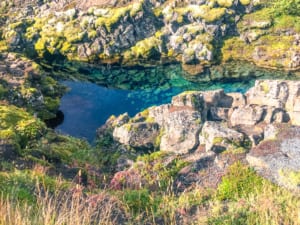 Summer at Silfra is lovely.
Summer at Silfra is lovely.
If you are in Iceland during the prime summer months of July to September you can expect others as well.
The water will be very cold as it is glacier water, but once you are finished with the dive you will quickly start to warm up.
The downside is that this is when a lot of people go to tour Silfra. Which can mean long lines, poor visibility due to knocking up the silt, and having to do the dive in groups.
 During my dive at Silfra in April, the outside temperature was colder than the water temperature. This meant that even though the water was cold, getting in the water was a bit of a relief from standing in the wind.
During my dive at Silfra in April, the outside temperature was colder than the water temperature. This meant that even though the water was cold, getting in the water was a bit of a relief from standing in the wind.
On the downside, since the air was below freezing once you go in do not surface as your gear will freeze over.
Once the dive was over, all the gear started freezing over during the walk back to the start point – and it was a grueling walk in the cold.
Upside of the dive during the winter? I was the only person there with a guide. Which meant we could take as long as we wanted during the dive and the visibility was perfect.
Silfra Snorkeling
If you aren’t SCUBA certified, or don’t want to do a dry suit certification, you can also opt to snorkel Silfra.
It’s a pretty similar experience. During the dive you do not go deeper than about 5-10ms. So the views you get while snorkeling along the top is pretty similar to the views that you will have during the dive.
The downside to being on the surface is the wind, and can lead to you becoming very chilly during the snorkel due to the air exposure.
Is Silfra snorkeling worth it? Yes, this is a once in a lifetime experience to touch to continental plates. There are not many people who can say that they accomplished this. Additionally, this is a great add-on to your Iceland Itinerary to highlight the “Ice” side of the Fire and Ice Island.
So should you dive or snorkel Silfra?
I would vote dive. It’s a unique experience, and if you are a beginner at dry suit diving it’s a great beginner level dive to grow comfortable in the suit.
Becoming Dry Suit Certified for Diving Silfra
As stated previously, dive shops in Iceland offer courses with diving Silfra packages. The certification process for Dry Suit by the dive shop I used was broken down into a three-day course. The first day at a pool along with a review of the course material, and then the second day occurs in a lake (which is pretty cold!). The third day was two dives at Silfra. All the gear was provided, so I just showed up to Iceland with my dive certification and began the dry suit course.
What’s the main difference between diving in wetsuit and diving in a dry suit:?
In a wetsuit, you are kept “warm” by water trapped. A wetsuit traps a thin layer of water between the neoprene insulation and your body. Your body warms the water, and then prevents too much loss of body heat. The thicker the wetsuit, the warmer you will be.
A dry suit, as the name sounds, keeps you dry. A dry suit is meant to prevent water from coming in contact with your body. This is done with tight seals around the wrists and neck. Under your dry suit will be undergarments to keep you warm, long socks, leggings, thermals, etc. Since the purpose of the drysuit is to be dry, the seals must be maintained that means try to prevent having on items that may tear the dry suit (jewellery) or chemicals that may degrade the dry suit (sunscreen, bug spray). The dry suit also has a valve connected to your air. You will inflate your dry suit with air to relieve pressure and adjust for buoyancy.
Dive Shops to Dive Silfra
Here are some of the dive shops that offer the opportunity to dive at Silfra. The one listed first is the dive shop that I used for my trip.
- Dive Iceland– this company offers dry suit courses in addition to diving Silfra. So if you are not already dry suit certified then you can complete the course prior to your dive. Dive Iceland also offers a Silfra Tectonic Course which teaches more about the tectonic plates.
- Scuba Iceland – additionally offers the dry suit course. This shop also has a PADI Volcano Dive Speciality course.
- Magma Diving – this dive shop does not appear to offer any diving courses but offers 3 day and 10-day dive trips.
Silfra from Above
Once you have dove Silfra, you may want to check out what it looks like from above.
There are helicopter tours that allow you to do just that. You can book a helicopter tour from Reykjavik that will do a fly over of the Silfra Fissure. This gives the opportunity to experience Silfra not only from below but from the air.
The trip in the sky shows just how vast the fissure is. We only venture into a small part of the area for the dive, and the actual fissure webs out across the surrounding area.
Frequently Asked Questions
-
- What makes Silfra unique for diving? Silfra is unique because it’s a fissure between the North American and Eurasian tectonic plates, providing an opportunity to dive in crystal-clear glacial water with incredible visibility.
- Do I need a special certification to dive in Silfra? While a basic Open Water Diver certification is required, many tour operators also recommend having a dry suit certification due to the cold water temperatures.
- How cold is the water in Silfra? The water in Silfra is consistently cold, with temperatures ranging from 2 to 4 degrees Celsius (35 to 39 degrees Fahrenheit) year-round.
- Can I dive in Silfra if I’ve never dived in a dry suit before? Some tour operators offer dry suit training on-site for those who haven’t dived in a dry suit before. However, prior dry suit experience is highly recommended.
- What is the visibility like in Silfra? Silfra boasts some of the clearest water in the world, with visibility exceeding 100 meters (328 feet). Divers can enjoy unparalleled views of underwater formations.
- Are there any restrictions for diving in Silfra? Divers should be in good physical condition, possess a valid diving certification, and follow the guidelines provided by the tour operator. Touching or disturbing the underwater environment is strictly prohibited.
- How long does a typical Silfra dive last? The dive itself usually lasts around 30 to 40 minutes, but the entire experience, including briefing and gearing up, can take several hours.
- Is diving in Silfra suitable for beginners? While beginners with an Open Water Diver certification can dive in Silfra, it’s recommended to have some prior cold-water diving experience and ideally a dry suit certification.
- What is the best time of year to dive in Silfra? Silfra can be dived year-round, but the summer months (June to August) are more popular due to milder weather conditions.
- Are there age restrictions for Silfra diving? Most tour operators have a minimum age requirement, typically around 18 years old. Some may allow younger participants with certain certifications and parental consent.


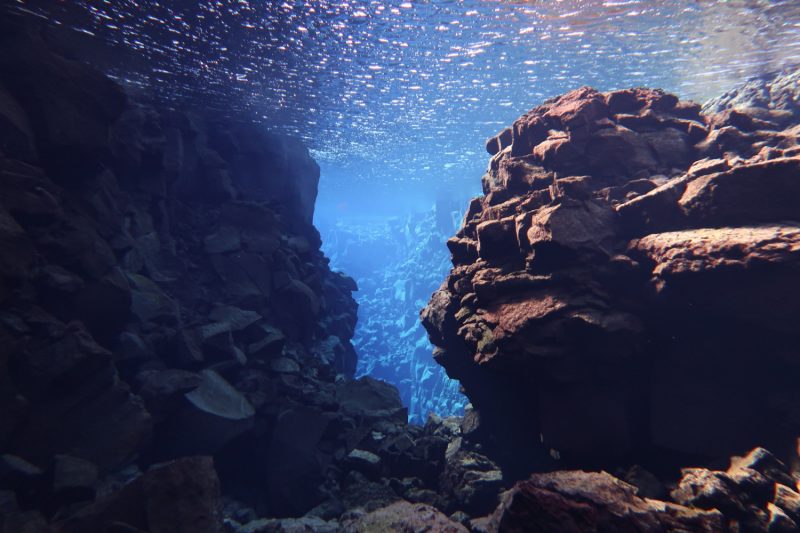

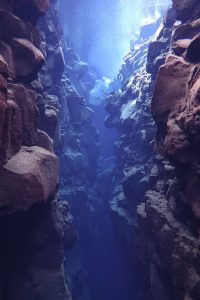

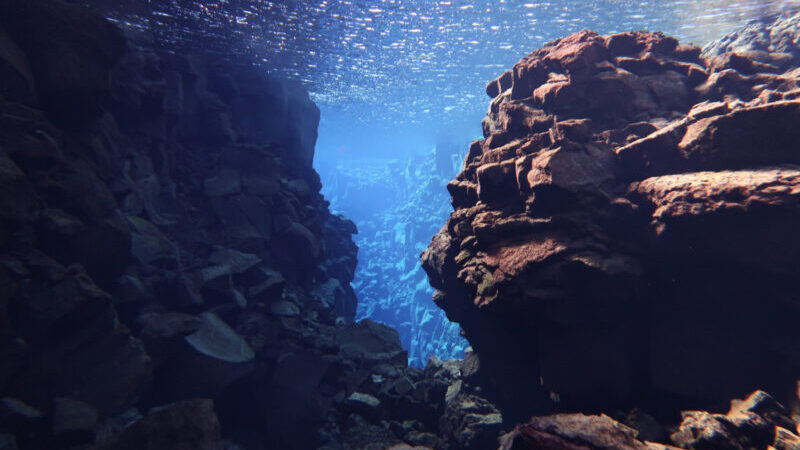


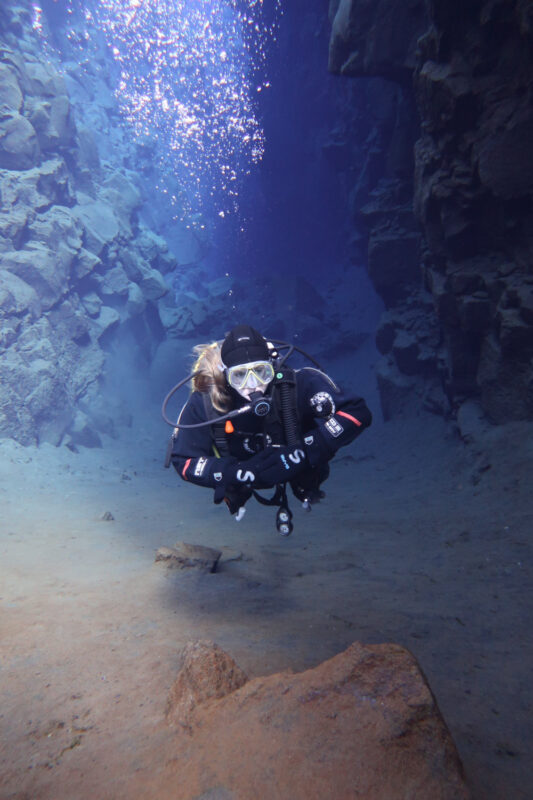

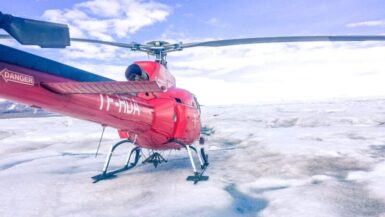
This is awesome! I didn’t even know Iceland was at the union of two tectonic plates, thank you so much for sharing.
What an amazing experience although it certainly doesn’t come cheap! I’m sure it was well worth the experience and I suppose it was a 3 day course that you had to undergo to prep yourself. I have never put on a dry suit before but then again I don’t dive and I’m not sure I could brave the cold. Beautiful photo of you diving. That water is clear as glass!
Wow! This is awesome. Your post made me miss diving. I think it was a year ago when we had our last dive. Now, we know what to do this coming weekend. Thank you for the inspiration.
Diving in Silfra sounds amazing! I recently had friends do this but snorkeling. I imagine that you still need the dry suits. Do you know if you have to have other tries first? It is just something so unique! They went in February, which I imagine is freezing! Any tips for snorkelers?
Amazing adventure. wish I could do this but my doctors won’t ever approve. Glad to be able to experience it in your photos and post.
I would love to do this! As a geologist the idea of swimming between two tectonic plates blows my mind. I didn’t know you needed to be certified, thanks fo the heads up! Probably need to book far in advance then if they are dropping the visitor numbers but 70%. Great write up
What an incredible experience, it’s definitely on my bucket list once I get a diving license 🙂 Thanks for this amazing guide, I’ll save it for my next trip to Iceland.
Loving the photos and I just have to add this to my bucket list, this looks amazing!! Thanks for sharing!
I have to go back to Iceland for this!
Wow, this sounds incredible. I just got my PADI certification last year, so I’m still learning about popular dive spots. Diving with a dry suit sounds a bit more tricky, but I’m sure it’s worth it for places like this!
I’ve always been a warm water diver, but seeing your photos and reading your review is tempting me to get certified to dive in a dry suit.
Thanks for the write up!
Wow. Diving is something I definitely need to get around to doing. Beautiful pics – this has gone straight to my bucket list destinations!
The biggest takeaway for me from this post was the difference between diving in a wetsuit and a dry suit! I had no idea that it was an option to dive in a dry suit but I love that idea because I can imagine how cold the water must be down there! It also seems like it’s a really expensive activity at $1000! However, it looks amazing and is definitely a unique place to dive at and I can imagine why you need to wait for it, with only one group allowed to dive in the fissures at a time. Love your pictures!
Wow, this is incredible! Not something we did in Iceland as diving scares me a bit but my goodness, that is so beautiful. I am so happy you got to experience this, looks like a once in a lifetime for sure!!
Wow! This looks spectacular!
What an awesome adventure! I considered doing this in Iceland, but I don’t have any experience so decided against it. Maybe something for the future 🙂
Wow! This looks amazing. Diving is one thing that I’m very nervous about. But these pictures make me want to face my fears!
What an amazing experience! The water is so clear. I just do snorkeling but I still feel like it would be something special to do it there.
The dry suit sounds quite challenging, but a good choice for this kind of diving. I visited a few years ago and loved Iceland, but I was so cold, I don’t think I could do this dive! I enjoyed reading about your adventures however!
Wow! This does not look like a novice level diving at all. I have never had this experience because I don’t know swimming. Your post is very informative for me – now I can tell the difference between dry suit and wet suite 🙂
Your adventures are truly inspiring
This is phenomenal! The dry suit bit sounds terrifying, but that is coming from someone that has dived just once. Your photos are truly awe-inspiring! This is definitely on my bucket list!
[…] If you are interested in more speciality courses that PADI has to offer then check out my post on diving Silfra and learning dry suit! […]
[…] National Park and you will be able to view the largest lake. This lake is where divers are going to dive at Silfra because of it being the continental rift between the North American Plate and the European […]
[…] Diving Silfra, Iceland – Dive Between Two Continents Tectonic Plates […]
[…] you want to maximize of a Fire and Ice trip to Iceland, then this hike is a must-do to truly experience the fire aspect of […]